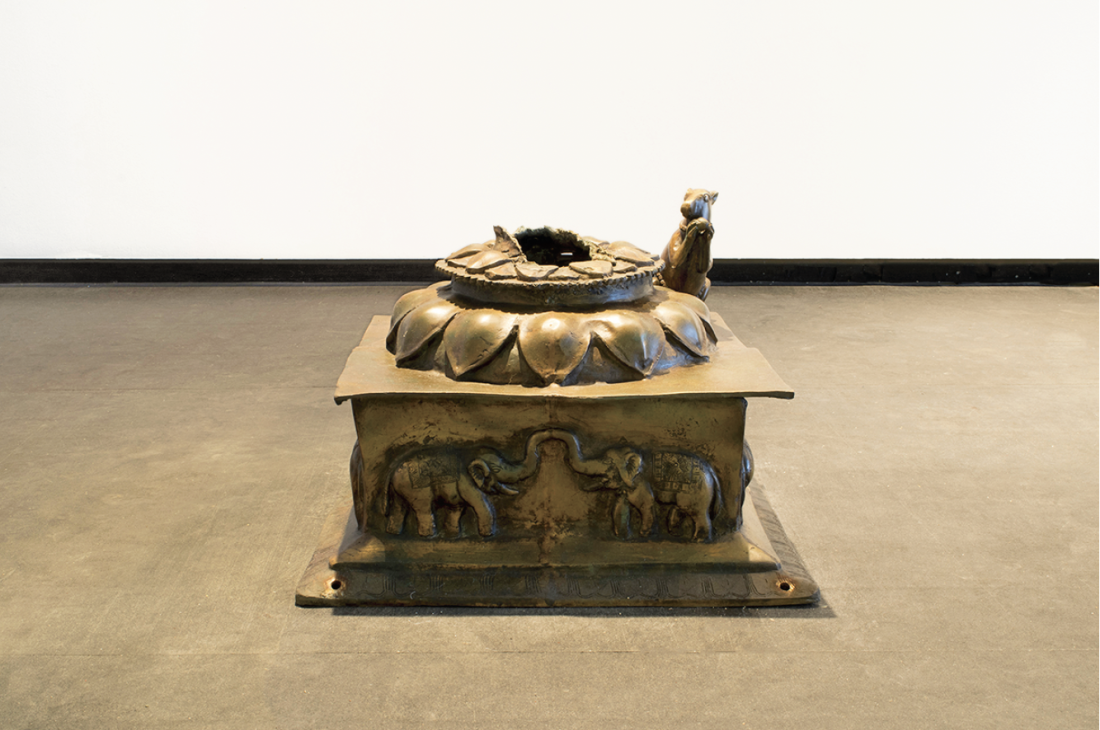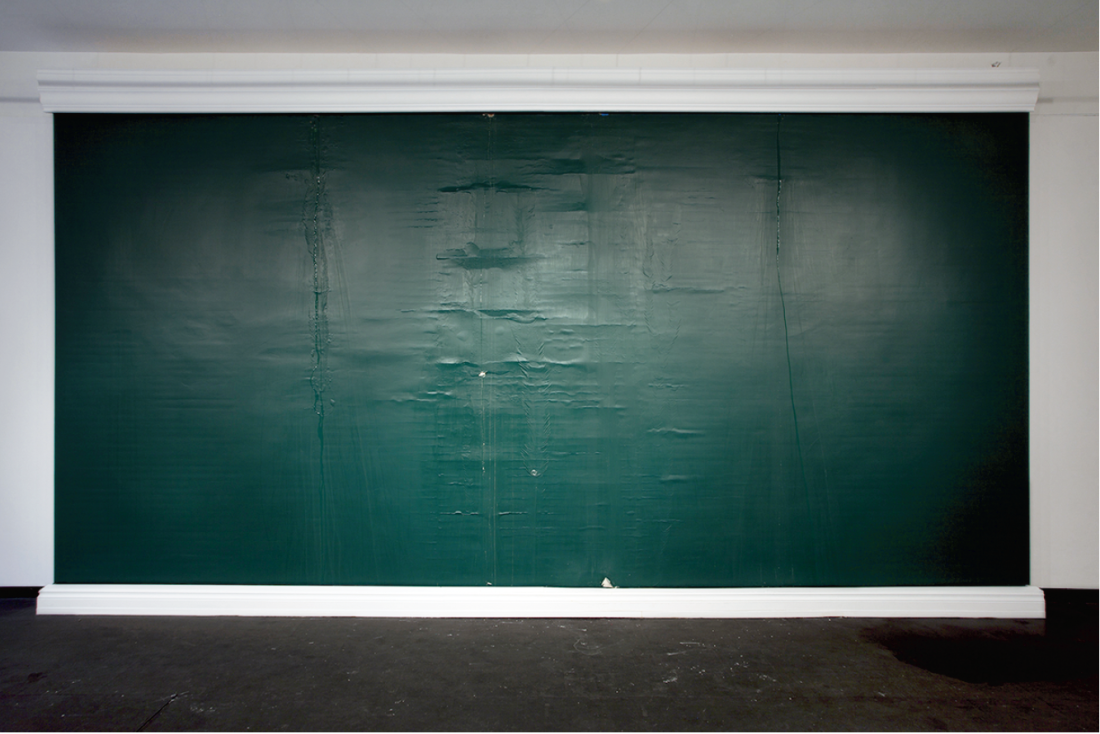Divya Mehra
In an attempt to mark and make acts of violence palatable, memorials are often characterized by longevity and perpetuity of encounter. These works are created within a clear paradigm of understanding, so that we know what happened, when and with what effect. Confronted with petrified fragments from the ruins of history, the act of remembering trauma is repressed by an anaesthetized grief. In contrast, Divya Mehra’s “It’s Gonna Rain,” a triptych of works presented at Calgary’s The New Gallery, asks the viewer to contemplate how the violence of grief can become a causal effect for an installation that emphasizes erasure, absence and the discontinuity of a narrative ruptured by shock.
At the gallery’s entrance is a brass base for a statue of Ganesh— the elephant-headed Hindu deity who welcomes visitors and stands as a symbol for overcoming obstacles. Titled We are obliged to learn life’s inevitable lessons and they are not easy (lies are necessary when the truth is too difficult to believe), the piece alludes to various synchronous phenomena that informed the content of this exhibition. Mehra’s father brought three statues of Ganesh to Canada. They each stood at the entrance to Mehra’s businesses, placed there to welcome guests. Shortly after his death, one of the statues was ripped from its base and stolen. The brutality of this transgression is evident in the snarled shards of brass remaining on the weathered base. All that is left is a mouse, a ubiquitous companion suspended on two feet overlooking the void left by the absent deity.

Divya Mehra, We are obliged to learn life’s inevitable lessons and they are not easy (lies are necessary when the truth is too difficult to believe), 2016, brass base to stolen Ganesh, 23 x 23 x 17 inches. Photo: Ashley Bedet. All images courtesy the artist and The New Gallery, Calgary.
Now the remaining base is placed at the entrance of the installation where it introduces twists of irony into the exhibition. The mouse, our host, whose name derives from the sanskrit root mūs (stealing, robbing), implies that this is a body of work asking that we bear witness to the absence indicated by what remains here in the defacement of the sacred. Consistent with Mehra’s earlier work, The Adversity of Exclusion can be made to go hand-in-hand with the Gifts of Inclusion, 2010, this piece reveals the incongruencies of diasporic identity with tenets of multiculturalism that indirectly position her as other. Known for creating personal work that uses humour to articulate deeply complex questions about multiculturalism and family history, in this exhibition the artist shows a radical departure toward a more modest gesture, especially in the grouping of individually named works. Rather than deliver a certain thread of memory or politic to the viewer, this exhibition creates space for contemplation that allows for a subjective assemblage of narrative(s).
Dominating the triptych is a lath and plaster wall painted British racing green, Mehra’s late father’s favourite colour and a tongue-incheek reference to postcolonial tensions of the artist’s diasporic identity. An honest Man (Even when the value of the object is gone, it is our feelings that keep it going) is a work that is eventually brought to ruin, as water continuously runs down the face of the wall. The sound of dripping water and smell of rotting plaster offer a palpable sense of ruin and decay. Mehra returned to India for the one-year anniversary of her father’s death to observe religious ceremonies that accompany this anniversary and to collect water from the Ganges to bring back for the exhibition. This sacred body of water—a location of transmigration—was combined with water from the Bow river, whose glacial source also purports to have healing properties. In this work, the water is not used to revive, rather, it hastens decay, creating fissures that are compounded over time, alluding to its eventual collapse.

An honest Man (Even when the value of the object is gone, it is our feelings that keep it going), 2016, drywall, acrylic deep base paint, water from Ganga River, water from Bow River, 27 x 10 feet (dimensions variable). Photo: Jeremy Pavka.
The seeds from this work derive from a pilgrimage taken by her father to a family house in Lahore that was lost when the family fled after the Partition. Hiring a photographer to document his trip, Mehra was struck by the aura of dispossession present in her father’s photos. The decaying plaster articulated a loss and unravelling of the threads of a tight-knit, prosperous family space. The wall in the New Gallery re-manifests this memory, while also implying that through decay, the spirit is released, purified by waters that can reinitiate the cycle of death and rebirth.
The final work in the exhibition, We are obliged to learn life’s inevitable lessons and they are not easy (lies are necessary when the truth is too difficult to believe), is a small ring cut from the base of a tree that once stood at the entrance to the Mehra’s restaurant. The tree was inexplicably removed by city crews months before the exhibition. Placed on the floor in front of the base of the absent Ganesh, it indicates a final rupture and violent act done to a once living thing made sacred by her father’s daily ritual of prayer. This final, synchronous act of random violence, and the artist’s placing of its remains in the exhibition, punctuates the contrasting gestures of this anti-memorial. As viewers, we are asked to collect the fragments of a narrative made linear through durational interventions that bring the work in the gallery to ruin, while simultaneously resisting linearity with a selection of discontinuous and ephemeral objects that point to what once was, rather than what is. “It’s Gonna Rain” is an exploration of transgressing the sacred, articulating the foundational premise of tragedy, and recognizing that it is only in hopelessness that we find hope. ❚
“It’s Gonna Rain” was exhibited at The New Gallery, Calgary, from September 9 to October 22, 2016.
Angela Henderson is an interdisciplinary Canadian artist and educator at the Nova Scotia College of Art and Design. Angela has shown work across Canada and Northern Italy and has participated in residencies in Canada, Italy and Austria.
Solomon Nagler is a film artist and professor of Media Arts at the Nova Scotia College of Art and Design. His films and installations have been exhibited internationally.

